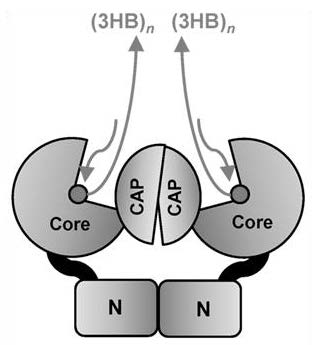PHA synthases (PhaC) are grouped into four classes based on the kinetics and mechanisms of reaction. The grouping of PhaC enzymes into four classes is dependent on substrate specificity, according to the preference in forming short chain length (scl) or medium chain length (mcl) polymers: class I, class III, and class IV produce scl-PHAs depending on propionate, butyrate, valerate and hexanoate precursors, while class II phaC synthesize mcl-PHAs based on the alkane (C6 to C14) precursors. PHA synthases of class I, in particular PhaCCs from Chromobacterium USM2 and PhaCCn/RePhaC1 from Cupriavidus necator/R. eutropha, have been analysed and the crystal structures of the C-domains have been determined. PhaCCn/RePhaC1 was also studied by small angle X-ray scattering (SAXS) analysis. Models have been proposed for dimerization, catalysis mechanism, substrate recognition and affinity, product formation and product egress route. The assays based on amino acid substitution by mutagenesis have been useful to validate the hypothesis on the role of amino acids in catalysis and in accommodation of bulky substrates, for the synthesis of PHB co-polymers and medium chain length-PHA polymers with optimized chemical properties.

